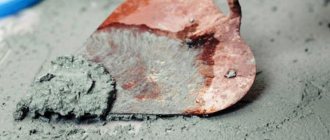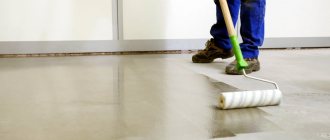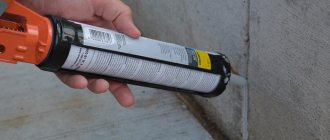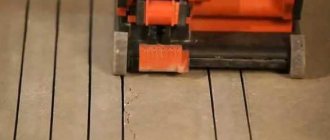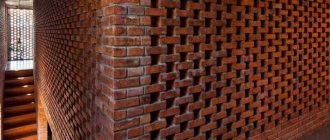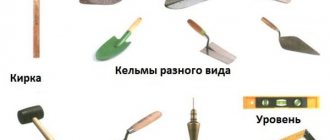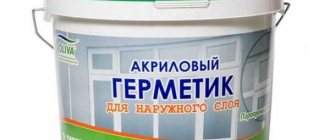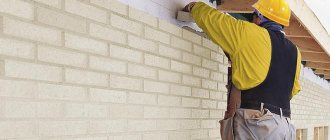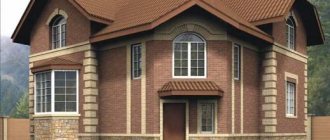Brick is a reliable and durable material, but external influences also have a negative impact on it. To maintain the attractiveness of the structure and extend its service life, it will be necessary to carry out strengthening work; brick varnish is often used for this purpose. The composition allows you to not change the appearance of the surface, but at the same time leaves a film coating that serves as a reliable protective barrier. For varnishing to be successful, you need to know the specifics of choosing the composition and its application. This will be discussed in detail below.
Varnishes for bricks for external and internal work
Brick varnish for exterior or interior use is a good option for obtaining protection from various influences. To treat the base in residential areas, it is necessary to use solutions that are not hazardous to human health.
When it comes to work on the outside of a building, it is necessary to use compounds that are resistant to natural factors. Accordingly, their reliability and strength should be increased.
Brick varnish for exterior or interior use is a good option for obtaining protection from various influences.
Why do you need to varnish brick?
Varnish for stone and brick helps to protect the material from exposure to water, temperature changes, wind, snow and other natural disturbances. The use of paint implies a change in the color of the base, and this option is not always suitable when designing a room; it may be necessary to preserve the original pattern.
The brickwork may suffer from mechanical shocks; the varnish layer will serve as a barrier so that the base does not collapse and repair work does not have to be carried out.
Varnish for stone and brick helps to protect the material from exposure to water, temperature changes, wind, snow and other natural disturbances.
Properties of paint and varnish
It is recommended to varnish a brick wall outside the building when climatic conditions require harsh exposure. The material itself looks beautiful, so not everyone wants to change its appearance, then varnishing is chosen. There are different varnishes on sale, but most compositions have common properties:
- Creating a film that prevents moisture penetration;
- Strengthen brickwork by being absorbed into the structure;
- They have a high level of adhesion;
- Resistant to chemicals and thinners;
- Withstands temperature changes;
- They are resistant to ultraviolet radiation;
- Increases the durability of the base;
- Create a beautiful decorative coating;
- Prevents the formation of mold and fungi.
It is recommended to varnish a brick wall outside the building when climatic conditions require harsh exposure.
Advantages and disadvantages
Varnish for decorative bricks or another type helps to obtain many positive properties, which is why these products are chosen to protect the base. Among the advantages of using varnishes, the following are noted:
- A water-repellent layer is created;
- Heat-resistant property when they are going to process stoves and other surfaces that are operated at high temperatures;
- Protection against the formation of salt deposits, the decorative property of the brick is preserved;
- Resistance to ultraviolet rays;
- You can create a matte or “wet stone” effect, obtaining the desired design in the end.
The disadvantages include the unpleasant odor that the solutions emit when used; after drying, the effect goes away. But when working, the master must protect himself with a respirator, gloves, and safety glasses.
Heat-resistant property when they are going to process stoves and other surfaces that are operated at high temperatures.
Composition of a DIY oven plaster solution
You can prepare the solution for the oven with your own hands. Fortunately, practice has developed many simple mortar compositions for plastering ovens. Above are the basic compositions that beginners can knead.
Before mixing the clay solution, the components are prepared:
- The clay is soaked a day (preferably 4-5) before use. After this, it is filled with additional water, the floating debris is removed, the water is drained, or stirred, passed through a sieve, then allowed to settle and the water is drained. The remaining clay is mixed until smooth. Any lumps will cause cracks. The resulting clay mass is combined with the remaining components.
- Sifted, washed, dried river sand is suitable. The recipes call for dry sand. When using wet sand, less water will be needed.
- Asbestos is fluffed up.
- Lime milk or dough is prepared from lime.
When plastering a stove with your own hands, it is important to maintain the proportions of the components. The clay solution can vary in the ratio of sand and clay, depending on the fat content of the latter. The standard procedure is to first mix the dry components followed by the addition of liquid components (clay or lime emulsion, water)
The standard procedure is to first mix the dry components followed by the addition of liquid components (clay or lime emulsion, water)
The standard procedure is to first mix the dry components, followed by the addition of liquid ones (clay or lime emulsion, water). The standard procedure is to first mix the dry components, followed by the addition of liquid ones (clay or lime emulsion, water).
Experienced stove makers add 200 g of salt to a bucket of solution. The additive prevents the appearance of cracks and slows down the setting of the mixture, which ensures uniform drying of the coating.
If you plan to heat the stove with coal or peat briquettes, which produce a high temperature, fireclay powder must be included in the composition.
Types of varnish for bricks
An important difference between varnish solutions is the component used in the base. The technical characteristics of the coating depend on the composition, so when choosing, you need to understand the features of the main options.
The technical characteristics of the coating depend on the composition, so when choosing, you need to understand the features of the main options.
Polymer varnishes
Polymer types are distinguished by their universal properties; they can be used indoors and outdoors where there is no heating. They create a layer that can withstand low temperatures, humidity, and are quick-drying. They can be used not only for processing brick, stone and other materials; they create a protective coating against rust with a high level of wear resistance.
Polymer products are easy to apply, so they are considered a good choice for beginners and are sold at an affordable price.
Polymer types are distinguished by their universal properties; they can be used indoors and outdoors where there is no heating.
Polyurethane varnish
Also classified as universal, applicable for internal and external surfaces. They receive reliable protection from natural influences and water; special pigments can be added to the composition to change the shade of the layer, if necessary. The surface acquires additional shine.
The use of varnish for application to external walls is popular due to its high level of protective characteristics against various influences.
They receive reliable protection from natural influences and water; special pigments can be added to the composition to change the shade of the layer, if necessary.
Solvent varnishes
This type is made from silicone resins, thanks to which the product penetrates well into the material, creating a reliable and elastic barrier. The colorless coating does not crack, remaining attractive for a long time.
Solvent compositions are highly flammable, so when using, you must follow safety rules.
This type is made from silicone resins, thanks to which the product penetrates well into the material, creating a reliable and elastic barrier.
Acrylic varnishes
Acrylic products are considered multi-component and are intended for interior work. The composition uses an organic type of thinners that protect the brickwork from the appearance of efflorescence, the layer does not crack and withstands mechanical shocks.
Acrylic products are considered multi-component and are intended for interior work.
What paint is suitable
Considering the range of paints and varnishes produced and sold, the question of how to paint a brick should not torment you much.
Otherwise, if this extremely important point is not taken into account, you will end up with a damp box that is practically unsuitable for living.
Properties of compositions
Let's determine what properties brick paint should have:
- The paint must be vapor permeable;
- For this purpose, it is necessary to choose a heat-resistant one, that is, one that can withstand temperature changes from –50°C to 50°C above zero. This is especially true in the northern regions, where such temperature changes are the natural norm;
- The composition of the material must be suitable for finishing brick surfaces. You should take into account in advance the fact that not every composition is suitable for this purpose;
- Brickwork, as a rule, has a high content of alkaline compounds, and this in turn can negatively affect the finishing coating, which is not intended for this purpose. Conclusion: it is advisable to take these points into account when choosing a particular type of paint.
Brick, in fact, was not originally intended for painting with your own hands. Being produced in a factory, it can have different geometric and color parameters and does not require any design manipulations.
Choose the right materials yourself
If the question of finishing arises, then it is advisable to use only those materials that fully meet all the stated requirements.
Many experts strongly recommend using silicate, cement or acrylic polymer-based compositions when decorating brickwork. Also, a silicone-based composition is perfect for external walls, but please note that it is much more expensive.
When choosing, it is better to give preference to compositions that do not contain solvents, since such coatings dry much faster, and this is a very important point, especially when finishing facades.
Painting of bricks should not be done with such types of compositions as, for example, fire-retardant paints for metal Polistil or, no less well-known, electrically conductive paint Zinga, since these protective coatings are intended for metal elements.
For particularly complex coatings, when the question arises, for example, of how to paint sand-lime brick, a water-based acrylic composition is most suitable here. Painting sand-lime brick requires a preliminary primer. If you do not follow this procedure, the coating will not last long.
In some cases, when cladding the external walls of a house or any other building, decorative bricks are used for painting. The composition of this material includes components that interact well and firmly adhere to paint and varnish coatings. Acrylic-based solutions are suitable for finishing such cladding.
The same compositions are used, for example, for painting a brick balcony or any other internal walls of buildings.
In general, compositions based on acrylic or silicone are completely universal and can be used on almost all surfaces, both stone and wooden, or covered with a plaster layer. They contain state-of-the-art polymer components that promote high-strength adhesion to substrates even as complex as silicate ones.
The surface treated with these materials is smooth and easy to clean. Another advantage worth noting is the maintainability of coatings. For repairs, it is not at all necessary to repaint the entire wall, but it is enough to update only the problem area.
Heat-resistant varnishes for bricks
Brick is often used when laying stoves; such structures require special heat-resistant varnishes. They must have the properties described below:
- Withstand high temperatures above 200-250 degrees;
- Resistance to water, so that mold and fungal formations do not appear over time;
- High level of adhesion, the composition must penetrate deeply into the material for high-quality protection;
- The presence of acrylic in the varnish so that drying takes less;
- Absolute colorlessness, then the decorative property will be good.
The following brands of similar varnishes are distinguished: KO85, KO815, Siltek-1.
Brick is often used when laying stoves; such structures require special heat-resistant varnishes.
Painting process
The preparatory part of the wall design process is mandatory and includes the following steps:
All peeling and interfering parts of brick and masonry cement mortar are cleaned from the wall and, if necessary, the seams are partially renewed;
- Before painting, it is advisable to strengthen the base with an acrylic primer. To do this, use a fairly wide brush or, even better, a spray gun to apply one layer of primer evenly over the entire surface. Often one layer will be enough.
- After priming, the base must be thoroughly dried.
Features of varnishing bricks
In order to carry out varnishing so that the coating protects the brick for many years, it is necessary to follow the working rules. Brick stain or varnish is applied in two layers, the operating temperature range varies from -10 to +30 degrees. Application tools include brushes, rollers, and spray guns.
In order to carry out varnishing so that the coating protects the brick for many years, it is necessary to follow the working rules.
Surface preparation
In order for the layer to lie evenly and beautifully on the surface, first prepare the base. If there is another old finish, it is necessary to remove it by heating it with a hair dryer and using a thinner. Remains of cement mortar are removed with a chisel and hammer.
On brickwork, small defects are repaired with latex-based paint, and the excess part is sanded with sandpaper. The cracks need to be widened and filled with mortar, then sanded to make them even with the rest of the surface. Then the following actions are performed:
- The base is cleaned of all types of contaminants; you can use a soap solution.
- Wait for the brick to dry.
- If efflorescence still remains, then wash with dishwashing detergent using a hard sponge.
- They wait again until the brick has dried.
- Move on to priming, take a deep penetration solution, it is advisable to use a product of the same brand as the varnish.
In order for the layer to lie evenly and beautifully on the surface, first prepare the base.
Subtleties of working with varnish
You can varnish a dry surface; choose a roller with long bristles up to 2 centimeters, or a brush with a thick, stiff brush. It is convenient to work with a spray bottle, it is easy to get a thin layer, but the device is expensive.
At the edges of the strips, the layer should overlap slightly with the other; start coating from the top corner. Multilayer coating is done by drying each layer. Optimal conditions for work will be calm, dry and warm weather.
Caring for the base is easy; you can simply remove dirt with a cloth soaked in soapy water.
Multilayer coating is done by drying each layer.
How to paint artificial stone
With such a variety of materials, it is quite difficult to choose what to cover with decorative stone.
The most popular options are:
- acrylic paint;
- vitriol;
- stain;
- various colored solutions.
Each of the materials has application features and properties.
Acrylic paint
Water-based wall paint is popular because it not only allows you to paint walls, but also protects the surface from weather conditions.
Acrylic paint for decorative stone has a number of advantages:
- elasticity. Due to changes in temperature conditions, cracks and deformations can form in the surface. Due to elasticity, this problem is eliminated;
- vapor permeability. This material perfectly absorbs and releases moisture;
- the ability to easily change color by adding color.
- resistance to ultraviolet radiation and moisture.
If you need to increase moisture resistance, you can choose a mixture with the addition of silicone.
Vitriol
Iron and copper sulfate are used as impregnation for walls made of natural stone. Such compositions increase the strength of parts. However, these compounds change the color of the treated surface. Iron sulfate turns the stone yellowish, and copper sulfate turns it blue. If this is exactly what you need for decoration, the elements should be immersed in the solution for a couple of hours in this way. So that they do not touch each other.
stain
Decorative gypsum coating for stone walls is treated with the same compounds as concrete. On sale, these mixtures are monochromatic, but if you want to diversify the palette, you can use wood stain. Acid stain is popular, but you should try the treatment on one plate before applying to all walls.
This is important, since gypsum stones can vary in composition
Other types of solutions
There are other options for solutions that can be used for coloring
When choosing what to paint the surface of walls to look like stone, you can pay attention to the following materials:
- varnishes;
- impregnations that can not only color the surface, but also improve their quality. Wet effect mixtures can create a shiny film on the stone and create the visual illusion of moisture on the wall;
- paints for plaster of any modification;
- compositions created with your own hands. In this case, the main thing is to choose the components wisely.
Compositions that can imitate natural stone have appeared on the building materials market. However, their cost is not yet available to everyone.
How to calculate material consumption
To understand how many cans of varnish to purchase, you need to calculate the area of the surface to be treated and multiply with the average consumption indicated on the label. The standard average consumption is 100-200 grams/per square meter.
But you should know that the indicator is influenced by the following points:
- Type of base, texture;
- Temperature indicators during operation;
- Composition of the product.
To understand how many cans of varnish to purchase, you need to calculate the area of the surface to be treated and multiply with the average consumption indicated on the label.
Recommendations for the use of VEPOX epoxy 2-component water-based enamel
Substrate requirements: The concrete base must be clean, free from traces of oil, areas of old coating and contaminants that impede adhesion. Fill defects and cracks with repair compound, sand and remove dust. Can be applied to damp concrete. New concrete floors must be at least 2 weeks old. Work can be carried out at air temperatures from +10°C to +35°C and humidity no more than 80%
Asphalt base: The surface must be clean. Do not contain oil, fat, be dried. Apply the material only if there is no deformation of the base during operation. When applying to asphalt, do not add water or prime!
Preparation of material: Ratio of mass parts of components A:B 100:17 Open the buckets with components A - (large bucket) aqueous dispersion of epoxy resin with additives and pigment. B- (small bucket) hardener. Using a low-speed drill with an attachment, mix component A, lifting the sediment of pigment and fillers from the bottom for 3 - 5 minutes. and pour into a clean bucket, making sure that there is no sediment left in the bucket from under component A, otherwise, repeat mixing. With the drill running, pour component B (pre-mixed) into the same bucket and stir for 3-5 minutes. Pour the resulting mixture into the empty bucket and stir for 3-5 minutes. Let it sit for 10 minutes. The life time of the material after mixing the components is 4 hours at a temperature of +20°C. During this time it is necessary to carry out application work and therefore you should not prepare more quantity than can be produced!!!
Application method: To improve wetting, the surfaces can be slightly moistened, but without puddles. Apply with a nylon roller with short pile (8-12mm) in a thin layer with a consumption of 200g/m². When performing the 1st (primer) layer, it is allowed to dilute the material with water (the recommended amount of water is 5–10% of the total mass), but only for the primer layer. Interlayer drying is 16 hours, but should not exceed 24 hours at t + 20°C and no more than 18 hours at t +25° - +30°C. Recommended number of layers is 2. If the air and base temperatures are below +15°C, a slower reaction and an increase in curing time must be taken into account. Pedestrian traffic is possible after 24 hours. Full loads after 5 days. VEPOX can be used as a primer layer on wet concrete and surfaces with capillary moisture suction under: PU-555 soil, Monourethane, PU-555 floor and similar PU materials. They can be applied 24 hours after applying VEPOX
It is important to remember that an impermeable barrier to moisture will be formed and it is necessary to provide ways to drain water from the concrete body. Ensure room ventilation
Cleaning of tools: Cleaning of tools after work must be done immediately with water. Subsequently, use solvent R-646, and after complete curing only mechanically.
Safety precautions: When carrying out work, use personal protective equipment (safety glasses, rubber gloves). Provide ventilation. In case of contact with eyes and exposed skin, rinse with plenty of water. Once cured, the material is safe.
Storage: Store in original packaging in a cool, dry place at a temperature not lower than +5°C. Shelf life: 6 months from the date of manufacture.
Varnish manufacturers
There are many varnishes available on the construction market that are suitable for processing brick. For this reason, it is difficult for beginners to make a choice; then you can focus on popular manufacturers:
- Pufas, the varnish of this brand adds a beautiful shine to the material, creating reliable protection against water;
- Petri, a popular polyurethane varnish that is resistant to abrasion and dirt, increasing the service life of the brick;
- Neomid, with a matte effect, does not emit an unpleasant odor, can be used inside a building, creating protection from water and biological formations;
- KrasKo produces several high-quality varnishes for brickwork.
Can be used inside a building, creating protection against water and biological formations.
Varnishes for brick surfaces are used to increase the durability of the material. There are several types of varnishes that can create a film coating that qualitatively protects the base from moisture, ultraviolet radiation, temperature changes and other influences, while maintaining the appearance of the brick unchanged. You can get a matte, semi-matte or glossy finish, improving the decorative properties.
What paint is suitable
Considering the range of paints and varnishes produced and sold, the question of how to paint a brick should not torment you much.
Otherwise, if this extremely important point is not taken into account, you will end up with a damp box that is practically unsuitable for living.
Properties of compositions
Let's determine what properties brick paint should have:
- The paint must be vapor permeable;
- For this purpose, it is necessary to choose a heat-resistant one, that is, one that can withstand temperature changes from –50°C to 50°C above zero. This is especially true in the northern regions, where such temperature changes are the natural norm;
- The composition of the material must be suitable for finishing brick surfaces. You should take into account in advance the fact that not every composition is suitable for this purpose;
- Brickwork, as a rule, has a high content of alkaline compounds, and this in turn can negatively affect the finishing coating, which is not intended for this purpose. Conclusion: it is advisable to take these points into account when choosing a particular type of paint.
Brick, in fact, was not originally intended for painting with your own hands. Being produced in a factory, it can have different geometric and color parameters and does not require any design manipulations.
Choose the right materials yourself
If the question of finishing arises, then it is advisable to use only those materials that fully meet all the stated requirements.
Many experts strongly recommend using silicate, cement or acrylic polymer-based compositions when decorating brickwork. Also, a silicone-based composition is perfect for external walls, but please note that it is much more expensive.
When choosing, it is better to give preference to compositions that do not contain solvents, since such coatings dry much faster, and this is a very important point, especially when finishing facades.
Painting of bricks should not be done with such types of compositions as, for example, fire-retardant paints for metal Polistil or, no less well-known, electrically conductive paint Zinga, since these protective coatings are intended for metal elements.
For particularly complex coatings, when the question arises, for example, of how to paint sand-lime brick, a water-based acrylic composition is most suitable here. Painting sand-lime brick requires a preliminary primer. If you do not follow this procedure, the coating will not last long.
In some cases, when cladding the external walls of a house or any other building, decorative bricks are used for painting. The composition of this material includes components that interact well and firmly adhere to paint and varnish coatings. Acrylic-based solutions are suitable for finishing such cladding.
The same compositions are used, for example, for painting a brick balcony or any other internal walls of buildings.
In general, compositions based on acrylic or silicone are completely universal and can be used on almost all surfaces, both stone and wooden, or covered with a plaster layer. They contain state-of-the-art polymer components that promote high-strength adhesion to substrates even as complex as silicate ones.
The surface treated with these materials is smooth and easy to clean. Another advantage worth noting is the maintainability of coatings. For repairs, it is not at all necessary to repaint the entire wall, but it is enough to update only the problem area.
Smooth color or special effects
It is better to paint a brick wall with a brush - it is easier to feel contact with the surface and apply even strokes. The direction of painting is horizontal, according to the masonry pattern. For acrylic paint, brushes made of polyester fiber are recommended (but high quality!), alkyd and oil paints require brushes made of natural hair. The universal size and shape of a tool for painting walls is a flat brush with a width of 75 to 100 millimeters. To work out the corners, brushes that are twice as narrow, with an obliquely cut edge, will be useful.
It is better to use a roller if you want to achieve the effect of a primer layer: brick absorbs a lot of paint at once, so it will take a long time to work with a roller on a smooth coating. But a carelessly rolled layer will turn out quickly and easily!
If you apply paint with a sponge, you will get the effect of old faded masonry. In this way, you can whiten the wall and make the paint layer translucent (as in the case of working with a roller). You can use a sponge to apply bronze or silver highlights, add spots of contrasting color to the wall, or paint over images using stencils.
Another common (but more labor-intensive) painting method is to paint each brick with a paint of the same tone using a brush and use a contrasting color compound for the joints.
Painting is one of the easiest ways to decorate brick walls with your own hands. To get a good result, you will need to properly prepare the surface, select paint and tools.
Designer delights
A few custom coloring ideas:
- Paint the bricks one color, the masonry joints another.
- Use 2 different colors or shades - in a checkerboard pattern, in stripes of 1 or several rows. In the interior of a nursery, 3-4 bright colors would be appropriate.
- In the bedroom, a brick wall can be made snow-white.
- The layer is made uneven, possibly simulating falling pieces. The wall is painted white or rich red. This method is used to create loft and gothic styles.
- "Semi-antique." Using a hammer and chisel or a screwdriver, break off small pieces of bricks and remove part of the mortar from the seams. Coarse-grain sandpaper or a grinder with a corresponding disc creates roughness and scratches. You can use a blowtorch to make several dark spots on the masonry. The entire surface is coated with a special impregnation. Then apply the paint with a sponge.
The easiest option for an inexperienced painter is to apply paintwork with a special texture roller. The result will be an original coating on which defects are barely noticeable or not visible at all.
Popular manufacturers
One of the proven and reliable manufacturers, which has been producing paint and varnish products for many years, is German. It offers more than 200 products, including varnishes and protective impregnations, which make brick walls more attractive and protected from moisture and destruction. The treated surface becomes silky and shiny, without changing its shade.
The Petri Corporation, located in the USA, is a stable manufacturer of paint and varnish products. This concern produces varnishes and impregnations that have the effect of wet stone. The protective products of this company are invariably of high quality; they are made on a polyurethane basis and prevent the destruction, abrasion and contamination of bricks.
, located in Russia, produces reliable Neomid STONE impregnation, used for bricks and decorative stones. The protective layer is matte or semi-matte and protects the walls from moisture absorption, mold and mildew. The varnish solution is odorless, so it can be used indoors.
is one of the leading domestic corporations that produces high-quality paint and varnish products. A line of products is produced for the protection of concrete and brick surfaces, the following very popular and effective varnishes are “Texil”, “Protexil”, “Aquastone”, “Epoxol”. Products are manufactured using modern technologies from high-quality, world-famous foreign materials.

